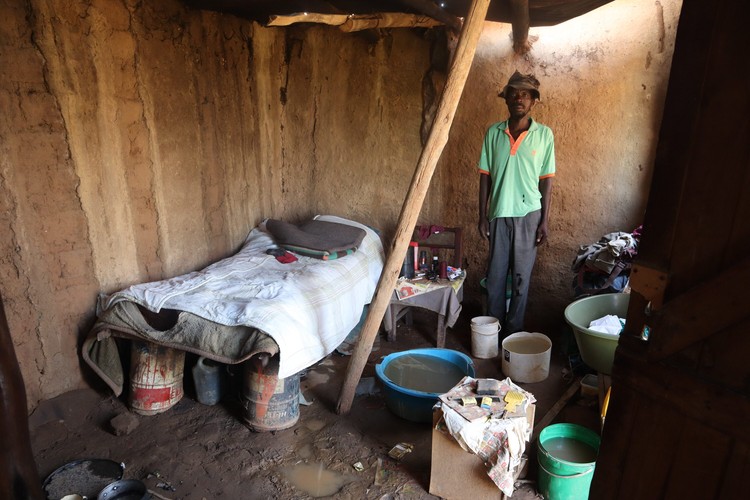Ladysmith flood victims want more help from government
Death toll since December is at 24
Patrick Dubazane stands in his home which has been damaged by recurring floods since September. Photos: Joseph Bracken
Flooding in Ladysmith, KZN, has killed 24 people since December. It has also left many people in the township of Thembalihle along the Klip River with badly damaged homes.
Residents told GroundUp they have been flooded numerous times since September, but they have received little relief from the municipality, so far only once receiving plastic bags to line their homes.
Ward councillor Xolani Mngadi responded that the municipality has also provided food vouchers to households that were worst hit.
One family still has a missing relative. Their body may have been found but DNA testing is currently being done to confirm this, according to Alfred Duma municipality spokesperson Thabisile Mkhize.
A recurring problem
Thembalihle resident Patrick Dubazane has struggled to stop the recurring floods from damaging his home. The house was not built to deal with so much water damage, he said. The floor, for example, has turned into a muddy sludge.
The stress of this has caused his “health to deteriorate”, said Dubazane. In order to fix his home and stop any further damage he needs better building materials, not just plastic bags.
A part of the roof collapsed on one of the buildings on Philasande Madlala’s family property on 23 December. Madlala has no materials to fix it. The floor is also damaged as the plastic bags the family were given are not enough to stop water from getting into the house.
Similarly, Zanele Mazibuko has not been able to stay in her home since one of the walls collapsed in September. She lived in the home with four people, now Mazibuko has had to rent a room nearby.
The roof of Philasande Madlala’s home collapsed in December.
Relocation plan overdue
Thembalihle is an informal settlement where many people have built houses where they were told not to, said Mngadi. The residents were warned they were building below the flood line.
There is a plan “which is long overdue” to relocate the residents, said Mngadi. A study by the Department of Human Settlements found that part of Thembalihle was “not conducive” to housing because of the nature of the soil next to the river. Residents were meant to be relocated to a safer area.
There were previous relocations of residents to housing built in other areas of Ladysmith, but people still built in Thembalihle and some residents came back, he said.
Next: PRASA settlement to double in size in spite of problems with water and sanitation
Previous: Many child support grant recipients left without money for January
© 2024 GroundUp. This article is licensed under a Creative Commons Attribution-NoDerivatives 4.0 International License.
You may republish this article, so long as you credit the authors and GroundUp, and do not change the text. Please include a link back to the original article.
We put an invisible pixel in the article so that we can count traffic to republishers. All analytics tools are solely on our servers. We do not give our logs to any third party. Logs are deleted after two weeks. We do not use any IP address identifying information except to count regional traffic. We are solely interested in counting hits, not tracking users. If you republish, please do not delete the invisible pixel.




